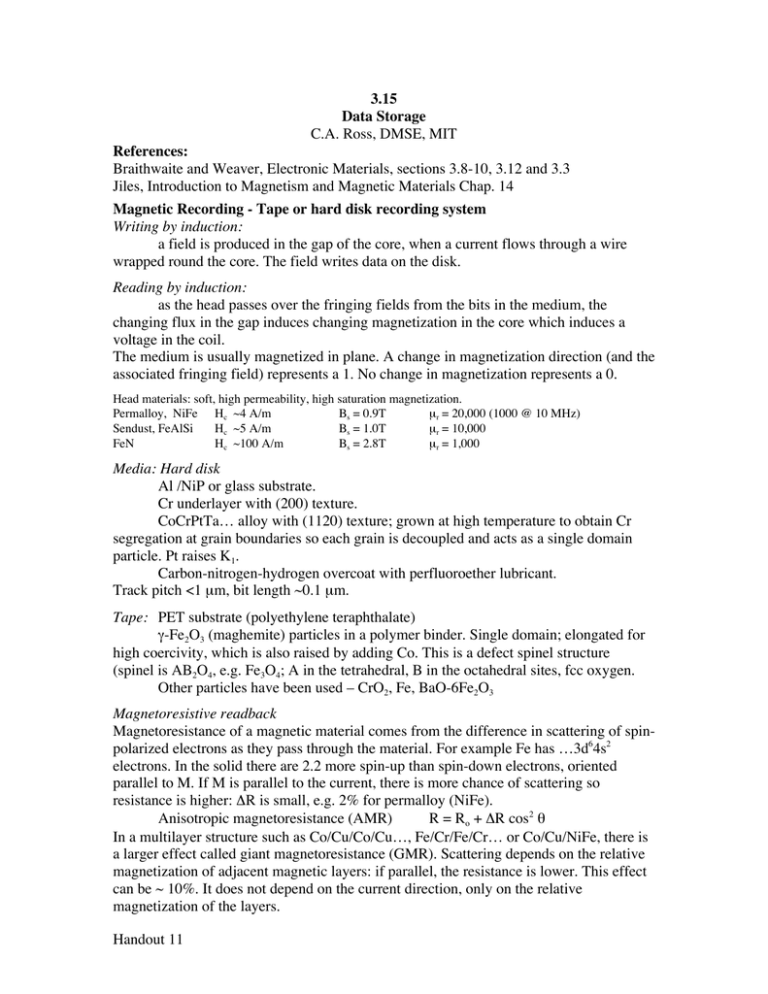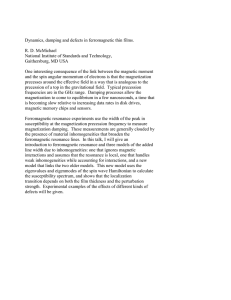3.15 Data Storage References: C.A. Ross, DMSE, MIT
advertisement

3.15 Data Storage C.A. Ross, DMSE, MIT References: Braithwaite and Weaver, Electronic Materials, sections 3.8-10, 3.12 and 3.3 Jiles, Introduction to Magnetism and Magnetic Materials Chap. 14 Magnetic Recording - Tape or hard disk recording system Writing by induction: a field is produced in the gap of the core, when a current flows through a wire wrapped round the core. The field writes data on the disk. Reading by induction: as the head passes over the fringing fields from the bits in the medium, the changing flux in the gap induces changing magnetization in the core which induces a voltage in the coil. The medium is usually magnetized in plane. A change in magnetization direction (and the associated fringing field) represents a 1. No change in magnetization represents a 0. Head materials: soft, high permeability, high saturation magnetization. Permalloy, NiFe Hc ~4 A/m Bs = 0.9T mr = 20,000 (1000 @ 10 MHz) Sendust, FeAlSi Hc ~5 A/m Bs = 1.0T mr = 10,000 FeN Hc ~100 A/m Bs = 2.8T mr = 1,000 Media: Hard disk Al /NiP or glass substrate. Cr underlayer with (200) texture. CoCrPtTa… alloy with (1120) texture; grown at high temperature to obtain Cr segregation at grain boundaries so each grain is decoupled and acts as a single domain particle. Pt raises K1. Carbon-nitrogen-hydrogen overcoat with perfluoroether lubricant. Track pitch <1 mm, bit length ~0.1 mm. Tape: PET substrate (polyethylene teraphthalate) g-Fe2O3 (maghemite) particles in a polymer binder. Single domain; elongated for high coercivity, which is also raised by adding Co. This is a defect spinel structure (spinel is AB2O4, e.g. Fe3O4; A in the tetrahedral, B in the octahedral sites, fcc oxygen. Other particles have been used – CrO2, Fe, BaO-6Fe2O3 Magnetoresistive readback Magnetoresistance of a magnetic material comes from the difference in scattering of spinpolarized electrons as they pass through the material. For example Fe has …3d64s2 electrons. In the solid there are 2.2 more spin-up than spin-down electrons, oriented parallel to M. If M is parallel to the current, there is more chance of scattering so resistance is higher: DR is small, e.g. 2% for permalloy (NiFe). Anisotropic magnetoresistance (AMR) R = Ro + DR cos2 q In a multilayer structure such as Co/Cu/Co/Cu…, Fe/Cr/Fe/Cr… or Co/Cu/NiFe, there is a larger effect called giant magnetoresistance (GMR). Scattering depends on the relative magnetization of adjacent magnetic layers: if parallel, the resistance is lower. This effect can be ~ 10%. It does not depend on the current direction, only on the relative magnetization of the layers. Handout 11 GMR is used to make readback heads. A stack called a spin-valve is used: Antiferromagnet-Ferromagnet-Nonmagnet-Ferromagnet. The AF pins the adjacent FM (the pinned layer). The other FM layer can rotate its magnetization in response to the fringing fields from the bits on the disk. The resistance of the stack depends on the angle between magnetization directions in the two magnetic layers, so is sensitive to the field from the disk. The AF can be FeMn, IrMn, NiO, etc; the FMs are Co or NiFe, and the nonmagnetic spacer is Cu (a spin valve) or Al2O3 (a tunnel junction). In the tunnel junction, resistance changes of ~50% can be achieved. Magnetoresistance is an example of a coupling between magnetism and electronic properties. There are many devices being developed to use these ‘magnetoelectronic’ or ‘spintronic’ phenomena, e.g. MRAM (magnetic random access memories). Magnetooptical Media Magnetooptical properties such as Faraday rotation are examples of a coupling between magnetism and optical properties. Kerr effect: polarized light is rotated on reflection from a magnetic material. Faraday effect: polarized light is rotated on transmission through a magnetic material. Kerr effects occur in all magnetic materials (Faraday effects also, if the material is transparent). Amorphous RE-TM alloys (rare earth – transition metals), e.g. a- (Tb,Gd)x(Fe,Co) 1-x where x ~ 0.2, have large Kerr rotations and are used in MO disks. Other materials are Co/Pt multilayers. The RE and the TM elements magnetize antiparallel so the materials are ferrimagnets. The magnetization of each group varies differently with temperature, so at some temperature the material is an AF because they exactly cancel.This is called the compensation temperature, and it is designed to be ~ 300K. At this point, the magnetization cannot be affected by an external field. To write, a laser spot heats the disk locally and a global magnetic field reverses its magnetization (which is perpendicular to the substrate, due to deposition of the film in a field during manufacture). To read, a weaker laser is used and the Kerr rotation shows which way the spot is magnetized (up = 1, down = 0). The Kerr effect comes mostly from the TM atoms so is high even at the compensation temperature. The disk is made of glass or plastic with dielectric/MO material/ dielectric/Al heatsink layer/protective coat. Optical media - CDs and DVDs Track pitch 1.5 mm, bit length 1- 2 mm. They look superficially similar to MO disks, but these rely on the reflectivity of a surface. In CDs and DVDs bits are encoded as small pits which lower the reflectivity Write-once media (WORM) uses Al films, Te alloys, organic dyes or semiconductors such as a-GaSb, where a laser permanently burns or melts the film to write a bit. Phase change media is a rewritable version, where the reflectivity depends on the cooling rate of the spot. Use Te alloys (fast cool – amorphous – reflective; slow cool – crystalline – less reflective). This can be rewritten many times. Handout 11







